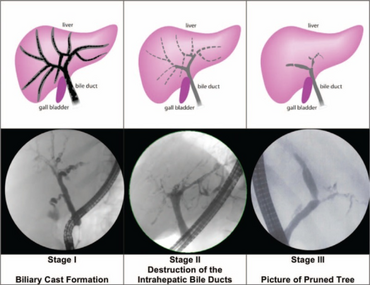Secondary sclerosing cholangitis
| Secondary sclerosing cholangitis | |
|---|---|
| Other names: SSC | |
 | |
| Cholangiographic findings of SCC-CIP. SSC-CIP = secondary sclerosing cholangitis in critically ill individuals | |
| Specialty | Hepatology |
| Differential diagnosis | Primary sclerosing cholangitis |
Secondary sclerosing cholangitis (SSC) is a chronic cholestatic liver disease. SSC is a sclerosing cholangitis with a known cause. Alternatively, if no cause can be identified, then primary sclerosing cholangitis is diagnosed. SSC is an aggressive and rare disease with complex and multiple causes. It is characterized by inflammation, fibrosis, destruction of the biliary tree and biliary cirrhosis. It can be treated with minor interventions such as continued antibiotic use and monitoring, or in more serious cases, laparoscopic surgery intervention, and possibly a liver transplant.
Signs and symptoms
The clinical presentation of an affected individual may initially be asymptomatic. However, over time the person may demonstrate:[1]
Cause
SSC is thought to develop as a consequence of known injuries or pathological processes of the biliary tree, such as biliary obstruction, surgical trauma to the bile duct, or ischemic injury to the biliary tree. Secondary causes of SSC include intraductal stone disease, surgical or blunt abdominal trauma, intra-arterial chemotherapy, and recurrent pancreatitis.[2] It has been clearly demonstrated that sclerosing cholangitis can develop after an episode of severe bacterial cholangitis.[3] Also it was suggested that it can result from insult to the biliary tree by obstructive cholangitis secondary to choledocholithiasis, surgical damage, trauma, vascular insults, parasites, or congenital fibrocystic disorders. Additional causes of secondary SC are toxic, due to chemical agents or drugs.[4][5]
Diagnosis
SSC is clinically related to primary sclerosing cholangitis (PSC), but originates from a known pathological process. Diagnosis of PSC requires the exclusion of all secondary causes of sclerosing cholangitis; else, if a known aetiology can be uncovered, SSC is diagnosed. Its clinical and cholangiographic features may mimic PSC, yet its natural history may be more favorable if recognition is prompt and appropriate therapy is introduced. Sclerosing cholangitis in critically ill patients, however, is associated with rapid disease progression and poor outcome.[6] Serologic testing, radiological imaging and histological analysis can help diagnose SSC.[7]
Treatment
First lines of treatment can include mass spectrum antibiotics or drainage of the bile duct that is infected followed by close monitoring.[8] Endoscopic surgery is favored over open procedures to reduce infection and quicker recovery times. If these fail a liver transplant may be necessary.[citation needed]
References
- ↑ RESERVED, INSERM US14-- ALL RIGHTS. "Orphanet: Secondary sclerosing cholangitis". www.orpha.net. Archived from the original on 24 June 2021. Retrieved 26 July 2022.
- ↑ Abdalian R, Heathcote EJ (November 2006). "Sclerosing cholangitis: a focus on secondary causes". Hepatology. 44 (5): 1063–74. doi:10.1002/hep.21405. PMID 17058222. S2CID 24663480.
- ↑ ter Borg PC, van Buuren HR, Depla AC (June 2002). "Bacterial cholangitis causing secondary sclerosing cholangitis: a case report". BMC Gastroenterology. 2: 14. doi:10.1186/1471-230X-2-14. PMC 116430. PMID 12057011.
- ↑ Kariv R, Konikoff FM (December 2002). "Sclerosing cholangitis--primary, secondary and more.". The Israel Medical Association Journal. 4 (12): 1141–2. PMID 12516911.
- ↑ Ruemmele, Petra; Hofstaedter, Ferdinand; Gelbmann, Cornelia M. (2009). "Secondary sclerosing cholangitis". Nature Reviews Gastroenterology & Hepatology. 6 (5): 287–295. doi:10.1038/nrgastro.2009.46. PMID 19404269. S2CID 11573923. Archived from the original on 5 June 2009. Retrieved 6 January 2017.
- ↑ "Causes of Secondary Sclerosing Cholangitis". Archived from the original on 23 March 2017. Retrieved 6 January 2017.
- ↑ Fan, David Sicong; Sorser, Serge Alexander; Gamarra, Roberto Mauro (2013). "Secondary Sclerosing Cholangitis due to Gallbladder Adenocarcinoma". Case Reports in Gastroenterology. 7 (1): 134–139. doi:10.1159/000345961. PMC 3617886. PMID 23626514. Archived from the original on 6 January 2017. Retrieved 6 January 2017.
- ↑ Björnsson, Einar S.; Gudnason, Hafsteinn O. (2017-06-23). "Secondary sclerosing cholangitis in critically ill patients: current perspectives". Clinical and Experimental Gastroenterology. 10: 105–111. doi:10.2147/CEG.S115518. PMC 5491618. PMID 28694703. Archived from the original on 2019-06-21. Retrieved 2019-06-21.
External links
| Classification | |
|---|---|
| External resources |